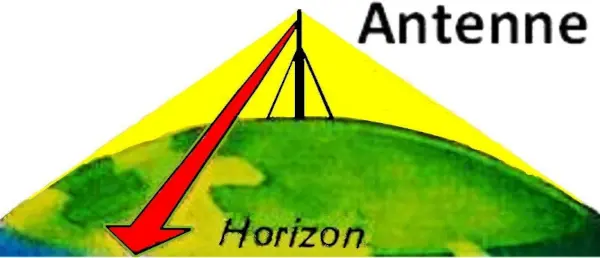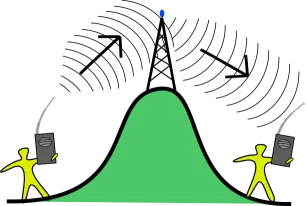Radio Wave Propagation and Its Influences
Radio Wave Propagation#

Radio wave propagation refers to the behaviour of radio waves as they travel from one point to another. This phenomenon is critical for understanding and improving various wireless communication systems. It is a vast subject, and this article only touches upon the complexities of radio wave propagation.
Summary#
This article explains how radio waves travel and how the sun's influence affects their transit. By exploring phenomena such as reflection, refraction, and diffraction, alongside the effects of environmental conditions, this document aims to provide a comprehensive overview suitable for enthusiasts and professionals alike. Understanding these principles is vital for optimizing frequency selection, designing mobile networks, implementing radio navigation, and operating radar systems efficiently.
Exploring the Journey of Radio Waves: From Transmission to Reception#
The fascinating world of radio wave travel offers a glimpse into how these electromagnetic marvels navigate from one location to another, seamlessly traversing the vacuum of space or meandering through the diverse layers of our atmosphere. Radio waves, cousins to the light waves visible to our eyes, embark on their journey subject to various atmospheric phenomena including reflection, refraction, diffraction, absorption, polarization, and scattering. This intricate dance with the elements is crucial for a myriad of practical applications - from setting the stage for amateur radio enthusiasts and global shortwave broadcasts to the intricate design of mobile phone networks, the precision of radio navigation systems, and the critical functions of radar operations.
The pathways of radio propagation are as varied as their applications. One of the most straightforward routes is line-of-sight propagation, where radio waves shoot directly from a transmitting antenna to a receiving one, akin to how we see objects that are directly in front of us. This method is the backbone of various medium-distance communications such as cellular phones, FM radio, television broadcasts, and the vast network of satellites orbiting above us. However, the Earth's curvature sets a natural limit to how far these signals can travel directly, a boundary extended only by the height of the antennas involved.
Venturing into the lower frequencies of the MF, LF, and VLF bands reveals a world where radio waves can gracefully curve over obstacles and follow the Earth's contour, thanks to diffraction. These surface waves or ground wave propagation enable AM broadcasts and amateur radio signals to reach their audience, even when they're tucked away behind hills or nestled in valleys. As we dip further into the very low and extremely low frequencies, we unlock the ability for signals to traverse globally, undeterred by water or land, a feature exploited for deep-sea communication and even contacting submerged submarines.
The mid-range frequencies of the medium wave and shortwave bands introduce us to the phenomenon of skywave propagation. Here, radio waves are cast upwards, only to be refracted back down to Earth by the ionosphere, allowing for cross-continental conversations and international broadcasts. This magical bounce enables amateur radio operators to connect across countries and continents, and broadcasters to reach a global audience.
Beyond these common pathways, radio waves also travel by lesser-known routes like tropospheric scattering, ducting, and near-vertical incidence skywave propagation, each playing a role when specific communication needs arise, such as achieving high-frequency connections over several hundred miles.
The journey of radio waves, from their emission to reception, is a testament to the intricate interplay between technology and nature. It's a realm where science meets practicality, enabling the global connectivity that we often take for granted today. Whether it's a call to a friend or tuning into a broadcast from halfway around the world, the invisible journey of radio waves makes it all possible, bridging distances and connecting us in ways that continue to astound and facilitate our daily lives.
Frequency dependence#
At different frequencies, radio waves travel through the atmosphere by different mechanisms or modes:
| Band | Frequency | Wavelength | Propagation via | |
|---|---|---|---|---|
| ELF | Extremely Low Frequency | 3–30 Hz | 100,000–10,000 km | Guided between the Earth and the D layer of the ionosphere. |
| SLF | Super Low Frequency | 30–300 Hz | 10,000–1,000 km | Guided between the Earth and the ionosphere. |
| ULF | Ultra Low Frequency | 0.3–3 kHz (300–3,000 Hz) | 1,000–100 km | Guided between the Earth and the ionosphere. |
| VLF | Very Low Frequency | 3–30 kHz (3,000–30,000 Hz) | 100–10 km | Guided between the Earth and the ionosphere.Ground waves. |
| LF | Low Frequency | 30–300 kHz (30,000–300,000 Hz) | 10–1 km | Guided between the Earth and the ionosphere.Ground waves. |
| MF | Medium Frequency | 300–3,000 kHz (300,000–3,000,000 Hz) | 1000–100 m | Ground waves.E, F layer ionospheric refraction at night, when D layer absorption weakens. |
| HF | High Frequency (Short Wave) | 3–30 MHz (3,000,000–30,000,000 Hz) | 100–10 m | E layer ionospheric refraction.F1, F2 layer ionospheric refraction. |
| VHF | Very High Frequency | 30–300 MHz (30,000,000– 300,000,000 Hz) | 10–1 m | Line-of-sight propagation.Infrequent E ionospheric (Es) refraction. Uncommonly F2 layer ionospheric refraction during high sunspot activity up to 50 MHz and rarely to 80 MHz. Sometimes tropospheric ducting or meteor scatter |
| UHF | Ultra High Frequency | 300–3,000 MHz (300,000,000– 3,000,000,000 Hz) | 100–10 cm | Line-of-sight propagation. Sometimes tropospheric ducting. |
| SHF | Super High Frequency | 3–30 GHz (3,000,000,000– 30,000,000,000 Hz) | 10–1 cm | Line-of-sight propagation. Sometimes rain scatter. |
| EHF | Extremely High Frequency | 30–300 GHz (30,000,000,000– 300,000,000,000 Hz) | 10–1 mm | Line-of-sight propagation, limited by atmospheric absorption to a few kilometers (miles) |
| THF | Tremendously High frequency | 0.3–3 THz (300,000,000,000– 3,000,000,000,000 Hz) | 1–0.1 mm | Line-of-sight propagation, limited by atmospheric absorption to a few meters. |
| FIR | Far infrared light (overlaps radio) | 0.3–20 THz (300,000,000,000– 20,000,000,000,000 Hz) | 1,000–150 µm | Line-of-sight propagation, mostly limited by atmospheric absorption to a few meters. |
Conditions Now#
The Sun and Its Influence#
The sun significantly affects radio wave propagation, particularly through its impact on the ionosphere. Light and ultraviolet rays modify ionospheric conditions, altering the behaviour of radio waves in the HF band and beyond.
More about Solar-Terrestrial Data
HF Propagation#
Light And Ultraviolet#
Light and ultraviolet radiation from the sun influence the ionosphere, playing a pivotal role in radio wave propagation.
Sunspots: The More, The Better#
Sunspots enhance radio wave propagation by increasing the ionosphere's reflectivity, making them a crucial factor in transmission quality.
Line of Sight Propagation#
Ideal line of sight propagation conditions require tall antennas without obstructions. However, real-world challenges such as terrain, vegetation, and atmospheric conditions complicate VHF and UHF transmissions.


Factors like surface-reflected radiation and the first Fresnel zone's integrity are critical for achieving optimal propagation. The complexity of these dynamics has spurred detailed research and extensive literature on the subject.
Conclusion#
Radio wave propagation is a complex but fascinating subject that underpins the functionality of modern wireless communication systems. From the influence of solar activity to the challenges posed by the Earth's natural and man-made features, understanding propagation is essential for advancing our capabilities in this field. As technology and research progress, our grasp of these principles will continue to evolve, offering new opportunities for innovation in wireless communication.